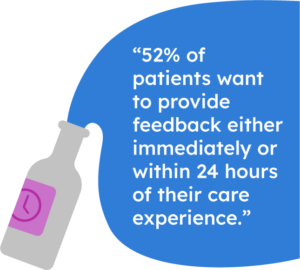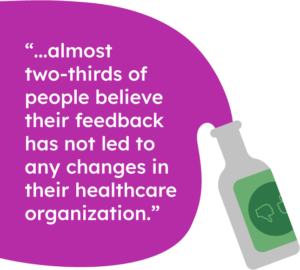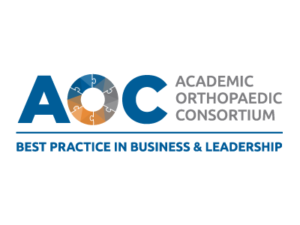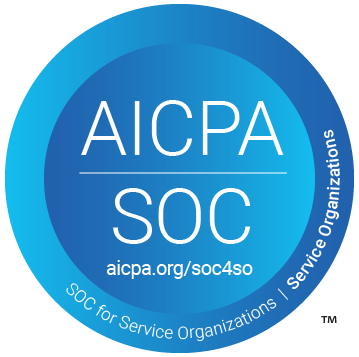Healthcare is facing a feedback crisis, and it’s not what you might think. Patients aren’t unwilling to share their thoughts about their care experiences—quite the opposite, actually. According to research, 95% of people want to provide feedback within a week of their healthcare experience. The real problem? Healthcare organizations are failing to meet patients where they are, when they want to be heard, or in the ways they prefer to communicate.
If you’re working in healthcare marketing or patient experience, this disconnect represents both a significant challenge and an enormous opportunity. Let’s dive into what patients are really telling us about feedback and how forward-thinking healthcare organizations can bridge this gap.
Timing Matters: Patients Want to Talk While It’s Fresh
 Here’s a striking statistic that should reshape how you think about patient feedback: 52% of patients want to provide feedback either immediately or within 24 hours of their care experience. Think about that for a moment. More than half of your patients are walking out of your facility with thoughts, feelings, and opinions they’re ready to share right now, not in two weeks when your traditional survey arrives in their mailbox.
Here’s a striking statistic that should reshape how you think about patient feedback: 52% of patients want to provide feedback either immediately or within 24 hours of their care experience. Think about that for a moment. More than half of your patients are walking out of your facility with thoughts, feelings, and opinions they’re ready to share right now, not in two weeks when your traditional survey arrives in their mailbox.
This immediate desire to provide feedback makes perfect sense when you consider the psychology of experience. The emotions, details, and nuances of a healthcare encounter are most vivid and accessible in those first few hours and days. Patients remember exactly how the front desk staff made them feel, whether their provider seemed rushed, and if they felt truly heard during their appointment. Wait too long, and those critical details start to fade.
The traditional healthcare feedback model—sending surveys weeks after an appointment—is fundamentally misaligned with when patients are most motivated and best equipped to provide meaningful input. It’s like asking someone to review a restaurant meal a month after they ate there. Sure, they might remember if the food was generally good or bad, but the specific details that could help improve the experience? Those are long gone.
The Channel Mismatch: Digital Preferences vs. Analog Methods
 Perhaps even more telling is the disconnect between how patients want to provide feedback and how healthcare organizations typically collect it. The research reveals that 51% of people prefer to provide feedback via online surveys, while almost a third want to communicate directly with their care team. Combined, that’s over 80% of patients who want digital, immediate, or personal feedback channels.
Perhaps even more telling is the disconnect between how patients want to provide feedback and how healthcare organizations typically collect it. The research reveals that 51% of people prefer to provide feedback via online surveys, while almost a third want to communicate directly with their care team. Combined, that’s over 80% of patients who want digital, immediate, or personal feedback channels.
Yet many healthcare organizations continue to rely heavily on traditional methods like mail surveys and phone calls—approaches that only appeal to 10% of patients combined. It’s a classic case of organizations designing processes around their internal convenience rather than patient preferences.
This channel mismatch isn’t just about convenience; it’s about meeting patients in their communication comfort zone. Today’s healthcare consumers regularly review purchases on Amazon, rate rides on Uber, and share thoughts about restaurants on Google. They expect the same seamless, immediate, consumer-friendly feedback options from their healthcare providers.
Direct communication with care teams also ranks high in patient preferences, which speaks to the desire for personal connection and the belief that feedback will be more impactful when shared directly with the people who provided the care. This preference reinforces the importance of relationship-building in healthcare—patients want to feel like their feedback matters to the specific individuals who cared for them.
The Trust Gap: When Patients Feel Unheard
 Here’s where the feedback crisis gets particularly concerning for healthcare organizations. While patients are willing to provide feedback, they’re increasingly skeptical about whether anyone is listening or acting on what they share. The research reveals that almost two-thirds of people believe their feedback has not led to any changes in a healthcare organization.
Here’s where the feedback crisis gets particularly concerning for healthcare organizations. While patients are willing to provide feedback, they’re increasingly skeptical about whether anyone is listening or acting on what they share. The research reveals that almost two-thirds of people believe their feedback has not led to any changes in a healthcare organization.
Breaking this down further, only 35% of patients feel like at least some changes have been made due to feedback they provided. Another 34% felt heard but didn’t believe any actions were taken, and 31% simply believe healthcare organizations have not been responsive to their feedback at all. This creates a vicious cycle: patients become less willing to invest time in providing thoughtful feedback when they don’t see evidence that it makes a difference.
This trust gap has real implications for your organization’s ability to gather meaningful data for improvement. When 57% of people report that providing feedback was either somewhat or not worthwhile, you’re not just losing current feedback—you’re potentially losing future participation as well. Patients talk to each other, and word spreads quickly when feedback feels like it disappears into a void.
The factors that most impact patients’ willingness to provide feedback further illustrate this challenge. Patients rated “the desire for my provider to make improvements” and “feeling like my feedback will not be heard” as the top factors. These represent both the motivation to help and the fear that efforts will be wasted. Other significant factors include concerns about how feedback might impact the patient-provider relationship and worries that negative feedback could affect future care.
What Patients Really Want to Talk About
When patients do provide feedback, what are they most interested in discussing? The research shows that patients want to be asked about three key areas: how they were treated, timeliness of care (particularly wait times), and whether their concerns and needs were addressed.
These preferences reveal something important about patient priorities. While clinical outcomes remain obviously crucial, patients focus equally on the human elements of their care experience. They want to talk about respect, communication, and feeling heard—the foundational aspects of human-centered healthcare.
The emphasis on treatment and care quality connects to patients’ desire for strong patient-provider relationships rather than purely transactional healthcare experiences. This aligns with what we know about patient satisfaction and loyalty: patients expect technical competence, but the interpersonal aspects of care often determine whether they feel truly satisfied with their experience.
Wait times and timeliness represent practical concerns that significantly impact patient experience but are often overlooked in traditional feedback mechanisms. These operational elements can make or break a patient’s perception of their care, regardless of clinical quality.
The Opportunity for Healthcare Organizations
Despite the challenges outlined in this research, there’s a significant opportunity for healthcare organizations that are willing to reimagine their approach to patient feedback. The key is creating systems that align with patient preferences rather than organizational convenience.
First, timing matters tremendously. Organizations need to implement feedback mechanisms that capture patient input while experiences are fresh, ideally within 24 to 48 hours of care delivery. This might mean automated email surveys that go out the same day as an appointment, text message feedback requests, or integrated feedback tools within patient portals.
Second, organizations cannot ignore channel preferences. The research clearly shows that patients want digital, convenient ways to provide feedback. This means investing in online survey platforms, mobile-friendly feedback tools, and potentially even social media listening capabilities. It also means training care teams to actively solicit and document direct feedback during patient interactions.
Third, and perhaps most importantly, organizations must close the feedback loop. The research shows that patients worry most that healthcare organizations won’t hear or act upon their input. Healthcare organizations need to become more transparent about how they use patient feedback, what changes they’ve made as a result, and how they’re addressing common concerns. This might involve regular communication about improvements, public dashboards showing patient feedback trends, or direct follow-up with patients who provide detailed feedback.
Building a Feedback-Driven Culture
 Creating effective patient feedback systems isn’t just about technology; it’s about culture. Organizations need to foster an environment where staff value, discuss, and act upon patient input at all levels.
Creating effective patient feedback systems isn’t just about technology; it’s about culture. Organizations need to foster an environment where staff value, discuss, and act upon patient input at all levels.
This means training staff to view feedback as a gift rather than criticism, implementing regular review processes for patient input, and celebrating improvements that result from patient suggestions.
The relationship between patient and provider remains central to effective feedback collection. When patients trust their care team and feel valued as individuals rather than just cases, they’re more likely to provide honest, constructive feedback. This reinforces the importance of relationship-building throughout the patient journey.
Healthcare marketing and patient experience professionals have a unique opportunity to lead this transformation. By advocating for patient-centered feedback approaches, implementing systems that meet patients where they are, and demonstrating the value of patient input through visible improvements, these roles can help their organizations build stronger relationships with patients while gathering the insights needed for continuous improvement.
At SocialClimb, we understand the evolving landscape of patient feedback and the importance of meeting patients where they are. Our platform helps healthcare organizations implement timely, convenient feedback collection methods while providing the insights needed to demonstrate responsiveness to patient concerns. Because when patients feel heard, everyone wins.











